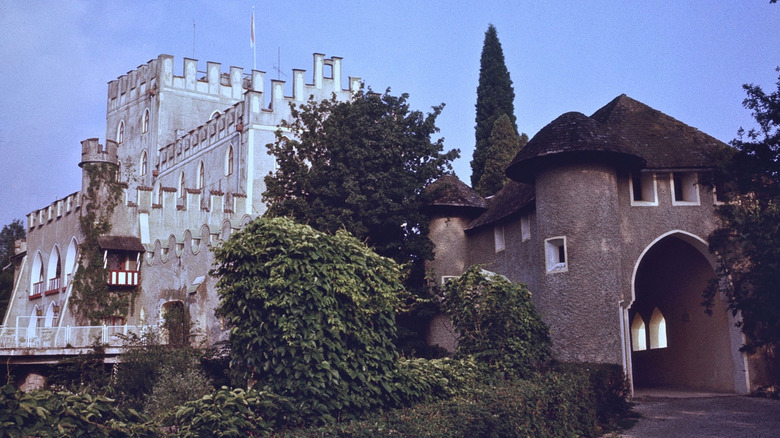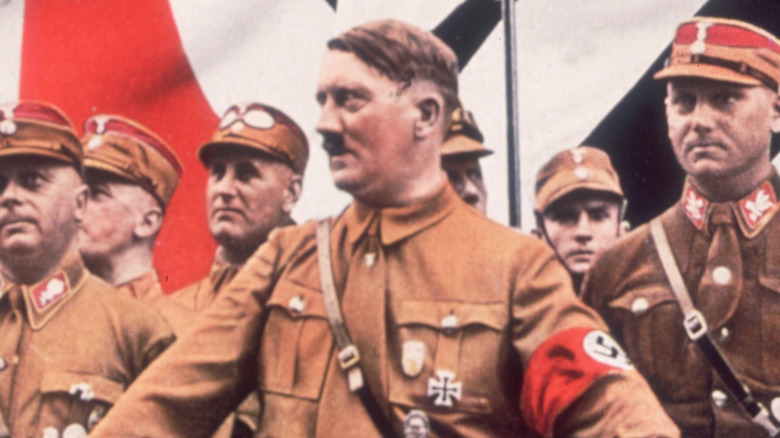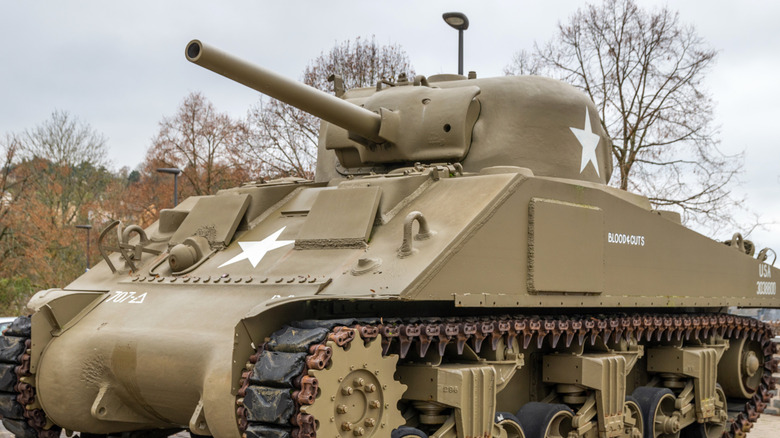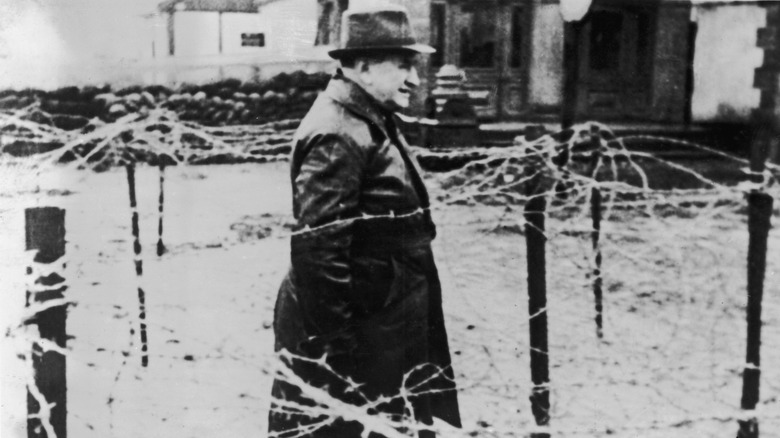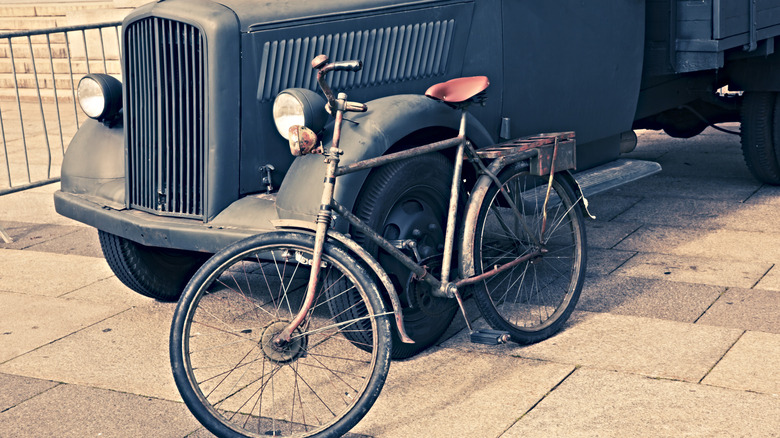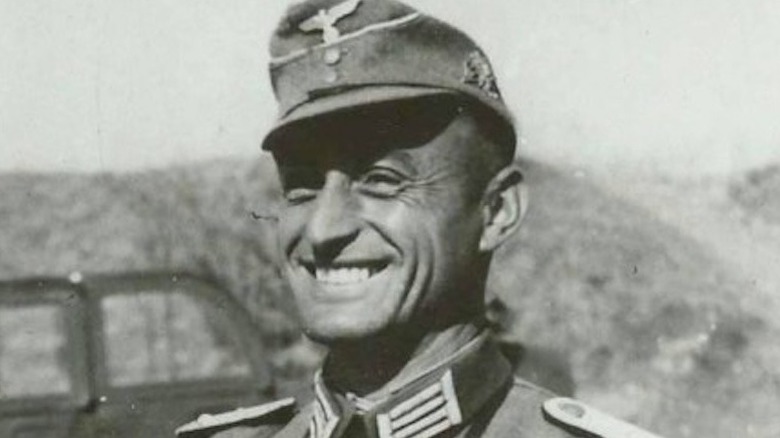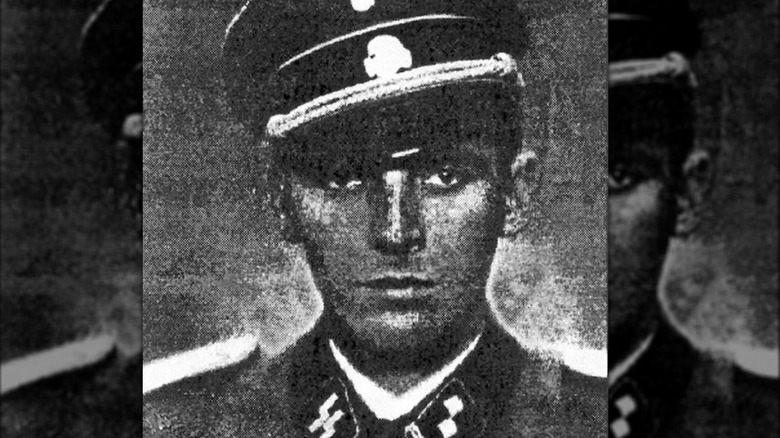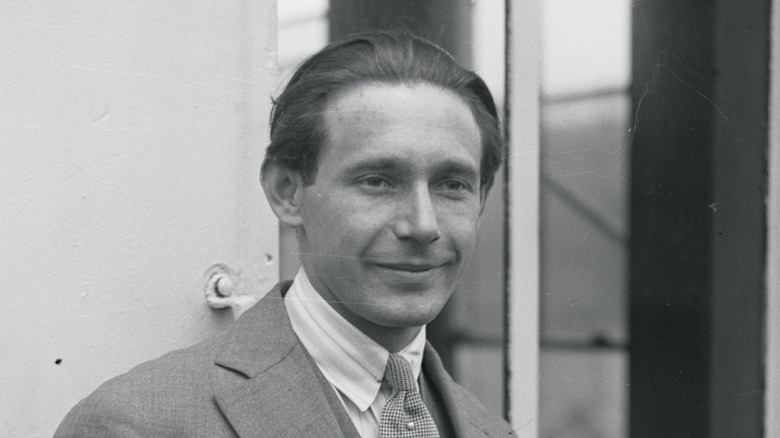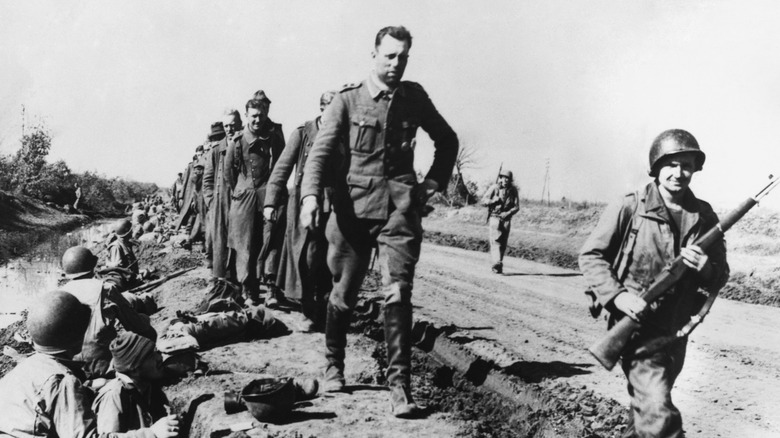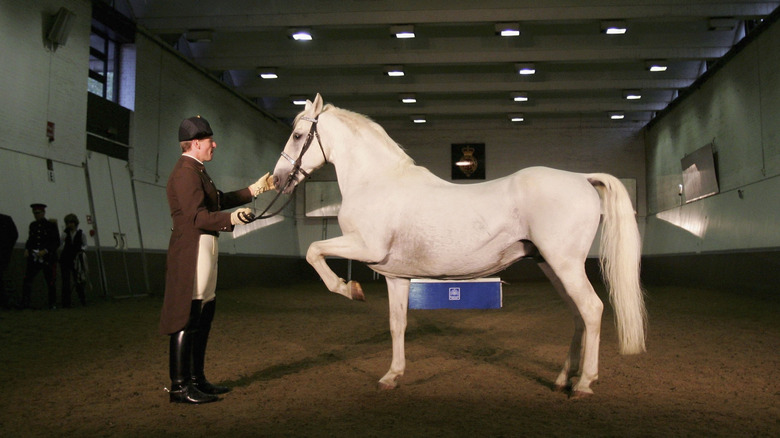When US And German Troops Fought Side By Side In WWII
By definition, wars have two sides, with an ideological and political line sharply dividing the combatants and their various allies. But war is a lot of things: horrible, violent, devastating, and complicated. The terrors of war endured by those left by their nations and leaders to fight it can lead to abrupt change. In the name of survival, or in the face of an outside menace or a profound threat, the people who fight wars may experience a shift in what they believe, renouncing the ideas they once were willing to die and kill for, and rethinking their battle strategies. Sometimes, wartime opponents find themselves inexplicably but also logically on the same side, united against a third enemy they realize they have in common.
Even during World War II, in which a lot of the world's civilized societies supported the U.S., U.K., and the Allied Forces in their quest to stop the fascists, imperialists, and Nazis of the Axis Powers' Italy, Japan, and Germany, respectively, some realignment took place. Very late in the years-long war, American troops, French prisoners of war, and Nazi soldiers came together to ward off other Nazis. So while World War II is discussed even more than World War I, here's a WWII story your history class didn't teach you: the bizarre events of the Battle of Castle Itter.
The state of World War II as it was ending
By April 1945, it was clear that the Allies would win World War II. As of late 1944, they'd expelled the Nazis from significant parts of the Netherlands, Belgium, and France while also occupying some sections of Germany. In February 1945, assured of victory, the leaders of the allied powerhouses of the U.S., U.K., and U.S.S.R. met at the Yalta Conference to discuss end-of-war and post-war arrangements for Europe. Just a month earlier, Nazi Germany's Führer," Adolf Hitler, had retreated to his bunker to escape the Soviet troops laying waste to Berlin. Then, on April 30, 1945, Hitler died by suicide, a significant blow to the already decimated Nazi cause, which was announced on May 1, 1945.
In the week or so between Hitler's death and Victory in Europe Day, when an unconditional Nazi surrender marked the end of World War II, the personnel that remained of the German war machine were increasingly left to fend for themselves. Ground-level, enlisted troops in the Nazi army, known as the Wehrmacht, abandoned their posts and jobs in the name of personal survival.
This was also true of many members of the SS, originally Hitler's personal protection that had evolved into the Nazi's paramilitary unit and ideology-driven secret police. A relative handful of diehard SS who still believed in the Nazi cause continued to fight, and those units roamed the Austrian countryside patrolling and looking for fights.
A castle turned prison was the site of one of the last battles of WWII
One of the final few battles of the European Theater of World War II took place in Austria, on the outskirts of a tiny town in the Nazi-aligned state of Tyrol, where the village of Itter sat below the shadow of Castle Itter. In 1940, two years after Nazi Germany annexed Austria (the nation of Hitler's birth), it occupied the ninth-century castle, – rebuilt in the 16th century — via an agreement with its owner, using it for various military purposes. In 1943, the Nazis forcefully ended the arrangement, seizing Castle Itter entirely and converting it into a prison.
Officially, Castle Itter was administered as one of the great many sub-camps or satellite affiliates of the Dachau concentration camp complex, which was situated about 90 miles away in Germany. Castle Itter wasn't set up to be a death camp, however, but rather a prison to specifically house French prisoners who were more valuable alive than dead. The Nazis held inmates as trophies of their war accomplishments, proudly incarcerating at the castle former French prime minister Edouard Daladier, Marie-Agnes Cailliau — the sister of exiled French prime minister Charles de Gaulle — high-ranking members of the French Resistance, and several celebrities and famous athletes, such as French tennis champion Jean Borotra.
Who wants to stage a prison break?
Morale and motivation were very low among the SS officials in charge of operating the prison at Castle Itter, and for good reason. The inevitability of the loss of the war, along with the death of Adolf Hitler, presented them with an uncertain and likely punishing future that awaited Nazi higher-ups, at the very least. Feeling unmotivated to fight or even keep the prisoners in line, the prison's leading SS officer, Commandant Sebastian Wimmer, asked his maintenance man, Zvonimir Cuckovic, to run an errand for him in a nearby town. Cuckovic wasn't SS, a Nazi, or German: He was a Croatian communist imprisoned for his political beliefs and forced into working for Wimmer.
Seizing the opportunity, he skipped out on the assignment and embarked on a treacherous, 40-mile bicycle journey through twisting, rocky, Austrian Alpine roads to get to Innsbruck. Cuckovich was actively looking for Allied soldiers, and he found a contingent of them on the very day that they helped liberate Innsbruck from Nazi occupation, developments that the prisoners were aware of from reports on a hidden radio.
The prisoner approached some American troops — the 103rd Infantry Division — with a proposition for their next project. They took up Cuckovich on his offer — in the form of a letter from the other prisoners, composed in English — to liberate the prison at Castle Itter.
Let the fighting and desertions begin
The next day, May 4, 1945, the 103rd Infantry mounted its siege on Castle Itter, sending a bevy of vehicles and firepower from its starting point in Innsbruck, Austria, about 40 miles away. The troops only got about halfway there before they had to turn around and head back to the staging area, thanks to heavy shelling by a small group of Nazi troops still trying to protect the area. Infantry officers were also concerned that the planned path to take to the castle would take it into a chunk of territory already liberated and occupied by a different American infantry unit, and that it wouldn't have time to clear the infringement.
It was around that time, after Zvonimir Cuckovic hadn't returned, that Wimmer fled the stronghold. Assuming — rightfully, it would turn out — that Cuckovich had attempted to find some Allied troops who would then attack Castle Itter, Wimmer decided it was time to desert. He took a military vehicle and drove away, and all of the other SS troops under his command followed suit.
The freed prisoners weren't yet free
With all the prison guards having fled the prison, all of them officers in the SS, to boot, this meant that Castle Itter had technically been liberated by default. The scores of mostly French prisoners were free to go, with no one on the premises preventing them from leaving. However, they weren't completely aware of what was happening outside the castle walls. While the SS officers on the grounds had left, they remained concerned about a Nazi presence surrounding the prison, and one which could easily and quickly return to the prison, or shoot them dead if they were caught wandering around rural Austria. Nor were they fully aware as to what Zvonimir Cuckovich was up to, or if he'd successfully persuaded friendly troops to liberate the prison.
The inmates at Castle Itter needed to take up arms against the enemy, hypothetical or real. There were indeed loyal SS units still roaming around the region, and so the prisoners would need to protect themselves with the stockpile of weapons that the departing SS had abandoned. The prisoners had become the defenders of their prison.
But first, a scouting trip
In order to find out what was going on outside of the prison, the assembled inmates of Castle Itter sent out Andreas Krobot, a Czechoslovakian prisoner who worked as the cook, to seek information and try to summon help. He grabbed a bicycle left behind by the SS and rode into the village of Worgl about 5 miles away. Fellow prisoner Zvonimir Cuckovic had considered heading there on his earlier rogue mission and was almost thwarted by Nazi soldiers. Krobot took a chance and found that while it hadn't been captured by Allied Forces, it wasn't in danger either. The large group of Wehrmacht troops once stationed there had abandoned the town in the final, unwinnable days of the war. The 10 Nazi artillery soldiers who stuck around no longer felt any drive to fight for Hitler, and under the watch of their commanding officer, Major Josef Gangl, they agreed to join the Castle Itter defense squad.
Krobot found another group in Worgl who wanted to help: members of the Austrian Resistance. The unlikely coalition of renounced Nazi soldiers, anti-Nazi Austrians, and a Czechoslovakian prisoner of the Nazis all voted to make the war-tested Major Gangl its leader. Gangl then gave his orders: free the village of Itter, then await American troop reinforcements, and then secure Castle Itter.
Enemies in war, comrades in this battle
It didn't take long for Major Gangl's collective of Wehrmacht soldiers, Austrian resistance fighters, and French prisoners to find the American personnel and weaponry it needed to defend Castle Itter, which was facing an imminent threat from the surrounding SS forces. The group drove into the nearby town of Kufstein, which had been freed from Nazi control by Allied troops, in particular the 23rd Tank Battalion of the 12th Armored Division of the U.S. XXI Corps, commanded by Lt. John C. Lee. That force remained in Kufstein, and it possessed heavy firepower in the form of five tanks.
An unlikely alliance of Lt. Lee and 14 American troops, Major Gangl, a driver, and a number of former Nazis headed to the castle with a truck and five powerful tanks. That was more than enough artillery and manpower to defend Castle Itter — too much, in fact. The group got so far up the road to the castle that it could only access it via an old and rickety bridge. It was determined that the defenders had one tank too many, and to prevent the destruction of the bridge, they sent one of those armored vehicles back to Kufstein. Nevertheless, they remained well equipped and easily fought off their first challengers — a group of SS officers who'd attempted to block off the rest of the road up to the castle.
Preparations get underway at the Castle
Similar to how the friendly forces making their way to liberate Castle Itter had decided that a Nazi officer should lead them into battle, those left inside the former prison pressed another reformed Nazi into a position of authority. Injured on the battlefield during World War II, SS officer Kurt-Sieffried Schrader recovered from his wounds near Castle Itter. Over his time there, he became such good friends with the population of inmates that he lost his passion for Nazism. But seeing as how he was the most seasoned military veteran on the premises, he was the most logical choice to head up the Castle Itter defense.
Schrader could handle the job, although he reportedly became a bit concerned, if not frightened, when the battalion led by Lt. Lee showed up at the castle's entrance. After clearing everything up — that the prison was no longer a Nazi stronghold, and that Lee was there to help — the two camps coordinated their efforts and formulated a plan. Schrader ordered his ad hoc unit to stand guard at spots around the outside of the castle. Meanwhile, Lt. Lee positioned his own tank, Besotten Jenny, at the gates of Castle Itter.
The battle begins, for real this time
When morning broke on May 5, 1945, about 150 troops from the Waffen-SS, one of the last actively fighting Nazi units in Europe, arrived at Castle Itter to reclaim the prison. The motley yet determined defending force of prisoners, resisters, American troops, and ex-Nazis held their own, preventing the invaders from entering the castle while suffering only minimal casualties. One thing that the castle denizens did lose, and quickly at that, was ammunition. They needed reinforcements, in the form of both fighters and weaponry, and so Lt. Lee put out a call to the 142nd Infantry Unit, but during the communication, the SS cut the line.
The American troops had only received a basic understanding of what was going on, and not much instruction nor specific needs were conveyed. For the 142nd to be effective, they'd have to get the full story, and inmate Jean Borotra offered to deliver it and escort the troops back to Castle Itter. The former world-class athlete got out of the castle by vaulting over the outer wall, and then ran through a corridor of SS troops. They fired directly at Borotra and from a fairly close distance. Somehow, he managed to avoid getting shot, and he traveled on foot to the American troops' staging spot. He was part of the brigade when it approached Castle Itter, looking to strike the SS attackers from behind.
The end of the fight and after
Jean Borotra guided the 142nd to Castle Itter, where they arrived at about 4 p.m. and apparently at the absolute nick of time, when the defenders had completely run out of ammunition. The SS troops attempting to attack and enter the castle turned their attentions to the well-armed American squadron coming up the road behind them, but their efforts were easily quelled by the 142nd. Just before nightfall, the battle was over. About 50 SS attackers had been killed, and the 100 or so survivors were transported away to enter the WWII program for German prisoners of war.
Castle Itter had been successfully defended as well as liberated. As for those held as prisoners before the Battle of Castle Itter, they were all immediately evacuated to Paris, from whence they were all sent home or to a safe location. Of the few casualties suffered by the castle defenders was ex-SS officer Josef Gangl, who was fatally shot by a Nazi sniper. Gangle was posthumously named an official national hero of Austria, and back in the U.S., Lt. John C. Lee, now one of the many lesser-known heroes of World War II, was awarded the Distinguished Service Cross for his efforts. Two days after the Battle for Castle Itter, Germany surrendered to the Allied Forces.
The other time Nazis fought alongside the Allies
Amazingly, the Battle of Castle Itter isn't the only time during World War II when Nazis and Allied troops found themselves on the same side. Just a few days before the Austrian castle was secured by a combination of American troops, French prisoners of war, and former-Nazi soldiers, Operation Cowboy took place in Hostau, which at the time was part of the German-governed Sudetenland, formerly part of Czechoslovakia and now located in the Czech Republic.
When Nazi Germany acquired Austria in 1938, it moved a group of Lipizzaners – famed dressage and show horses housed in Vienna — to a farm in Hostau. Just as the Nazis intended to create a "master race" of ideal Aryan humans, they also wanted to breed idyllic, perfect horses. By the end of April 1945, the Soviet Red Army was marching in from the east at virtually the same time that the American XII Corps, led by General George Patton, was heading in from the west; both were competing to liberate the Czechoslovakian city of Prague from Nazi control.
While most people generally don't eat horses, the Americans who got there first believed that the depleted Soviets would eat the horses or use them as work animals. And so, they met with the head of the farm's riding school, Alois Podhajsky. The Americans and horse-rearing Nazis teamed up to evacuate the horses while under attack by outside Waffen-SS troops before the Soviets even arrived.
